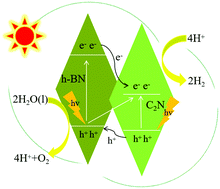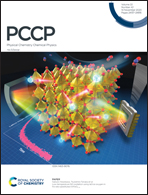A two-dimensional h-BN/C2N heterostructure as a promising metal-free photocatalyst for overall water-splitting†
Abstract
The construction of a heterostructure (HS) is an effective strategy to modulate the desired properties of two-dimensional (2D) materials and to extend their applications. In this paper, based on the density functional theory, we predict a metal-free type-II HS formed by h-BN and C2N single layers. The h-BN/C2N HS possesses a smaller bandgap than individual h-BN and C2N single layers, and it exhibits excellent visible light absorption. Importantly, its band edge positions satisfy the requirements for spontaneous water-splitting. With the assistance of the built-in electric field across the HS and the band offset, the photoinduced carriers can be readily spatially separated. Free energy calculations indicate the high catalytic activity for water oxidation and reduction reactions. The performance can be further enhanced by strain, which modulates the bandgap and the band edge positions of the HS. The band alignment may undergo a transition from type-I to type-II under strain, offering an effective switch for the reaction. The appropriate bandgap, suitable band edge positions, and effective carrier separation make the h-BN/C2N HS a promising candidate for use as a photocatalyst in water-splitting.



 Please wait while we load your content...
Please wait while we load your content...